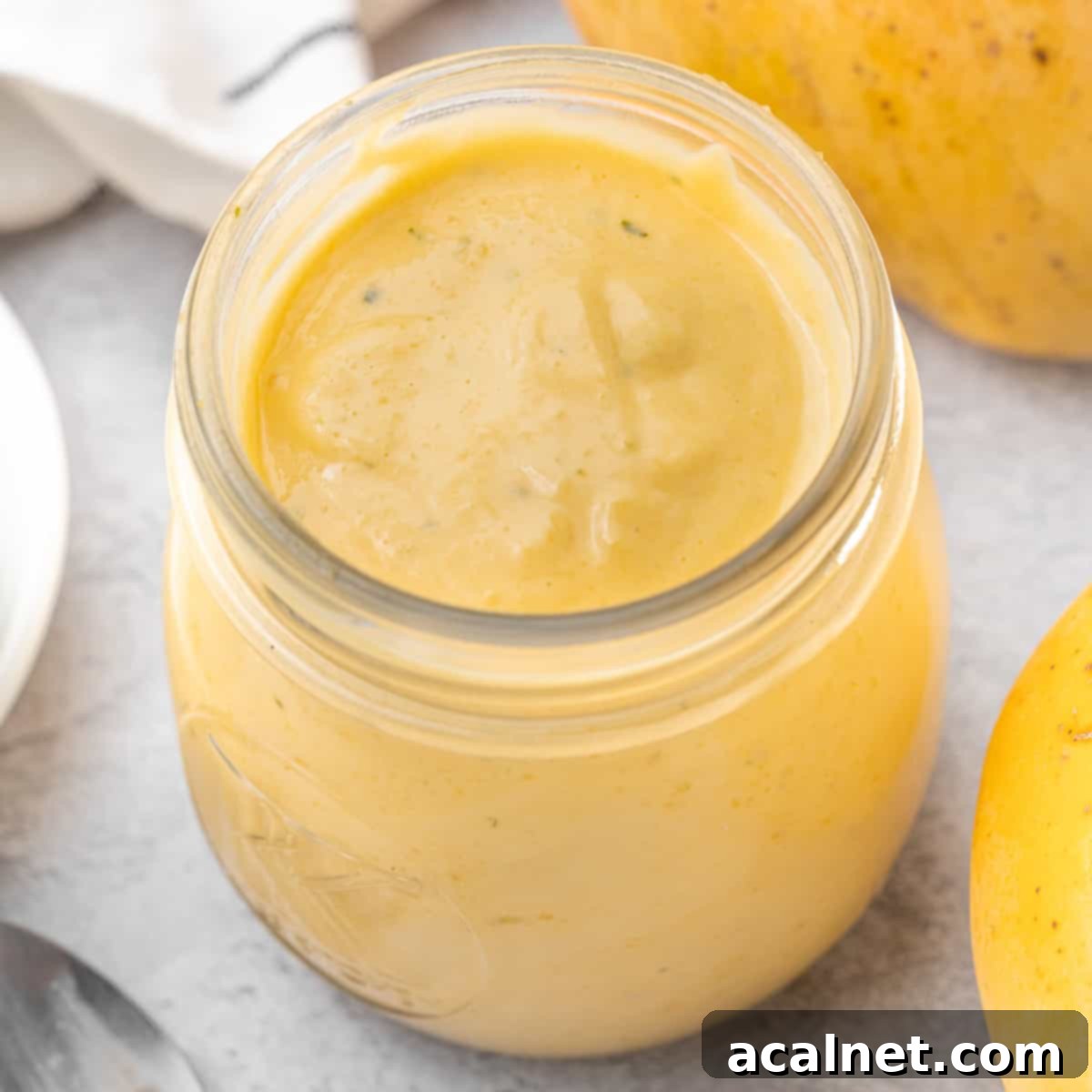Easy Homemade Mango Curd: A Zesty Tropical Delight
This easy homemade Mango Curd is a truly delightful creation – lusciously light, wonderfully fresh, and incredibly creamy. The vibrant, sweet flavors of ripe mango are perfectly harmonized by a bright touch of tangy lime, elevating this curd beyond a simple spread. It transforms into an ideal sweet accompaniment for breakfast, a gourmet topping for desserts, or a luscious filling for pastries and cakes. Prepare to embark on a tropical journey with every spoonful of this vibrant, golden treat.
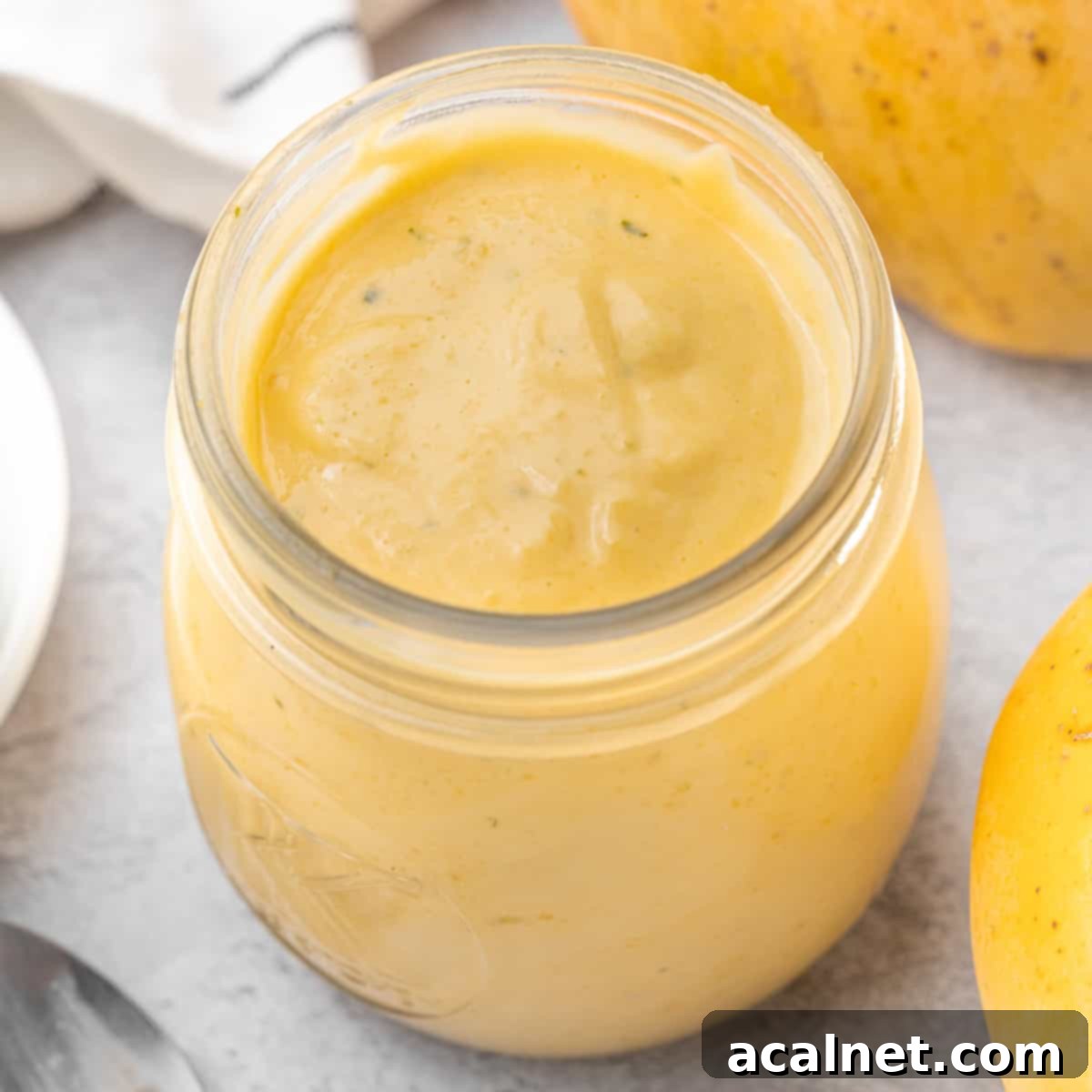
Why You’ll Adore This Mango Curd Recipe
This 5-ingredient mango curd recipe offers an incredibly easy and rewarding way to utilize ripe mangoes, transforming them into a gloriously creamy, brightly flavored, and utterly irresistible fruit spread. There’s something truly special about a homemade curd, and this mango version takes that classic comfort to a new, exotic level.
Its versatility is unmatched. Imagine it generously spread on your morning toast, delicate scones, fluffy waffles, or golden pancakes. Drizzle it over scoops of vanilla ice cream or a bowl of creamy yogurt for an instant dessert upgrade. It’s also an exquisite filling or topping for elegant tarts, delicate macarons, or grand cakes, such as this stunning Mango Mousse Cake. The vibrant yellow hue and tropical aroma alone are enough to make your taste buds sing.
Using mango adds a simple yet incredibly indulgent tropical twist to the beloved classic lemon curd. Just like in our popular Mango Coulis recipe, the fresh mango flavor in this curd is inherently sweet and bright. This sweetness is beautifully balanced by the tangy, zesty notes of fresh lime juice and its aromatic zest, creating a symphony of flavors that is both refreshing and deeply satisfying. This isn’t just a spread; it’s a taste of sunshine in a jar.
Explore More Fruit Curd Recipes:
- Orange Curd
- Passionfruit Curd
- Apple Curd
- Raspberry Curd
Essential Ingredients for Perfect Mango Curd
Crafting this vibrant mango curd requires just a handful of simple ingredients, proving that extraordinary flavor doesn’t always demand a complex list. Each component plays a vital role in achieving that perfect creamy texture and tangy-sweet balance.
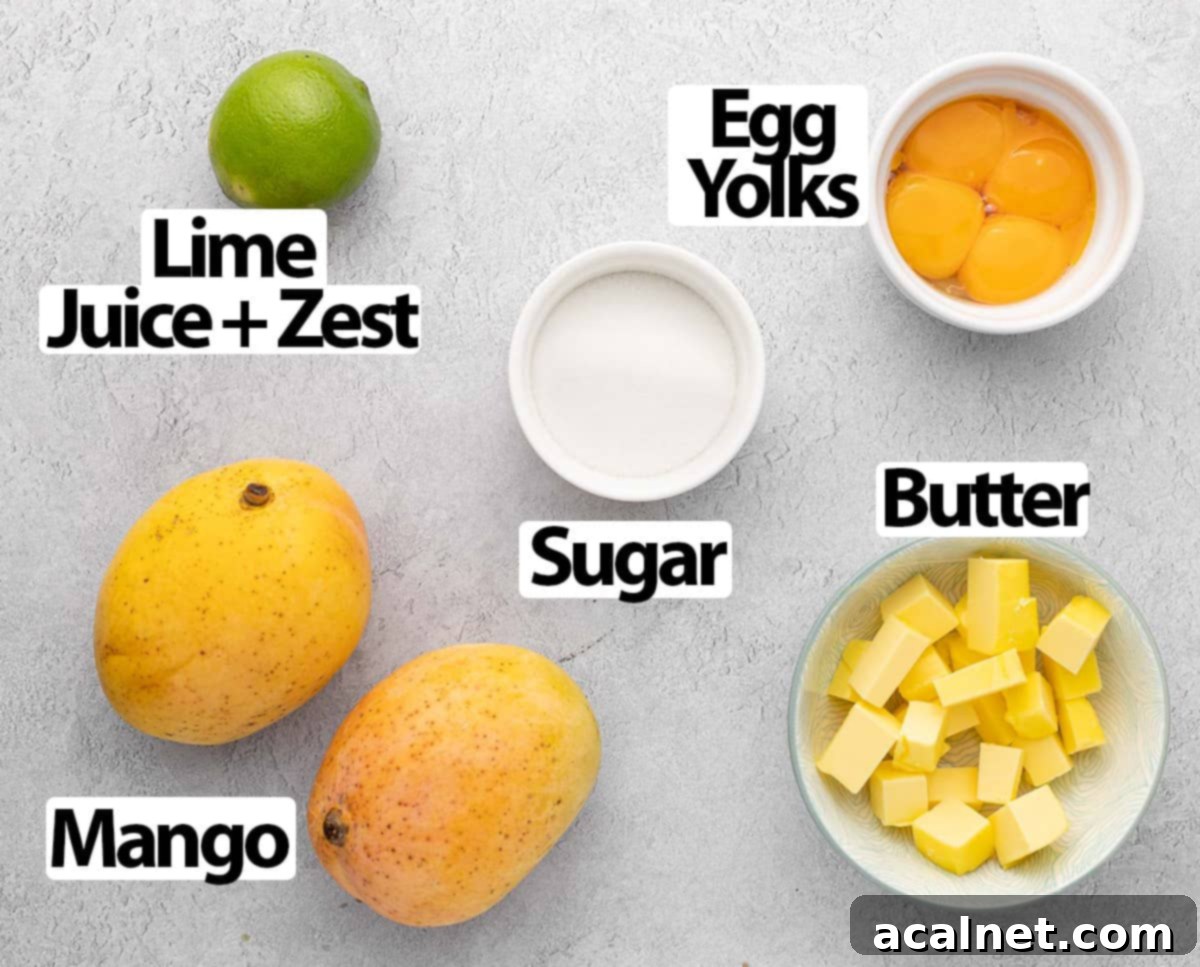
Scroll down to the recipe card below for all exact quantities.
Here’s what you’ll need to make this delectable mango curd:
- Mango: The star of our show! You’ll need fresh mango flesh, blended into a smooth puree. The key to incredible flavor lies in using truly ripe, sweet mangoes. If fresh mangoes aren’t in season or readily available, you can absolutely use frozen mango chunks, ensuring they are fully thawed and drained of any excess liquid before blending. Store-bought mango puree can also work in a pinch, provided it’s 100% mango with no added sugars or preservatives that could alter the taste.
- Eggs: Specifically, large egg yolks. It’s crucial that your egg yolks are at room temperature. Cold eggs can cause the mixture to curdle when they hit the heat, leading to a lumpy texture. Save those leftover egg whites for other delicious recipes, like delicate Financiers or light meringues!
- Lime: We’ll be using both the aromatic zest and the fresh juice of a lime. While lemon juice and zest can be substituted, lime offers a slightly milder, more nuanced tang that beautifully complements the tropical sweetness of mango. It brightens the flavor without overpowering it.
- Sugar: Caster sugar or superfine granulated sugar is recommended. Its fine texture dissolves quickly and evenly, ensuring a smooth curd without a grainy mouthfeel. You can adjust the quantity slightly based on the sweetness of your mangoes and your personal preference.
- Butter: Unsalted butter is preferred, as it gives you control over the overall saltiness. Ensure it’s at room temperature (but not too soft or melted) and cut into small cubes. Adding butter in stages contributes to the curd’s luxurious, creamy texture and smooth finish.
Optional Additions for Enhanced Flavor and Texture
While the core ingredients create a fantastic mango curd, a few optional additions can further refine its taste and consistency:
- Cornstarch: If you plan to use this mango curd for specific applications that require a thicker, more stable consistency – like piping into macarons or tarts, or as a sturdy cake filling – a small amount of cornstarch can be added. It acts as a stabilizer, helping the curd set more firmly and preventing it from becoming too runny.
- Salt and / or Vanilla: Both are excellent flavor enhancers. A tiny pinch of salt can really make the mango and lime flavors pop, much like it does in baking. A splash of vanilla extract (or the seeds of half a vanilla bean) can add a layer of warm, sweet complexity, harmonizing beautifully with the tropical notes.
How to Master Homemade Mango Curd
Making mango curd is a straightforward process, but paying attention to a few key details will ensure a silky-smooth, perfectly set, and wonderfully flavorful result. Follow these steps for a truly exceptional tropical treat:
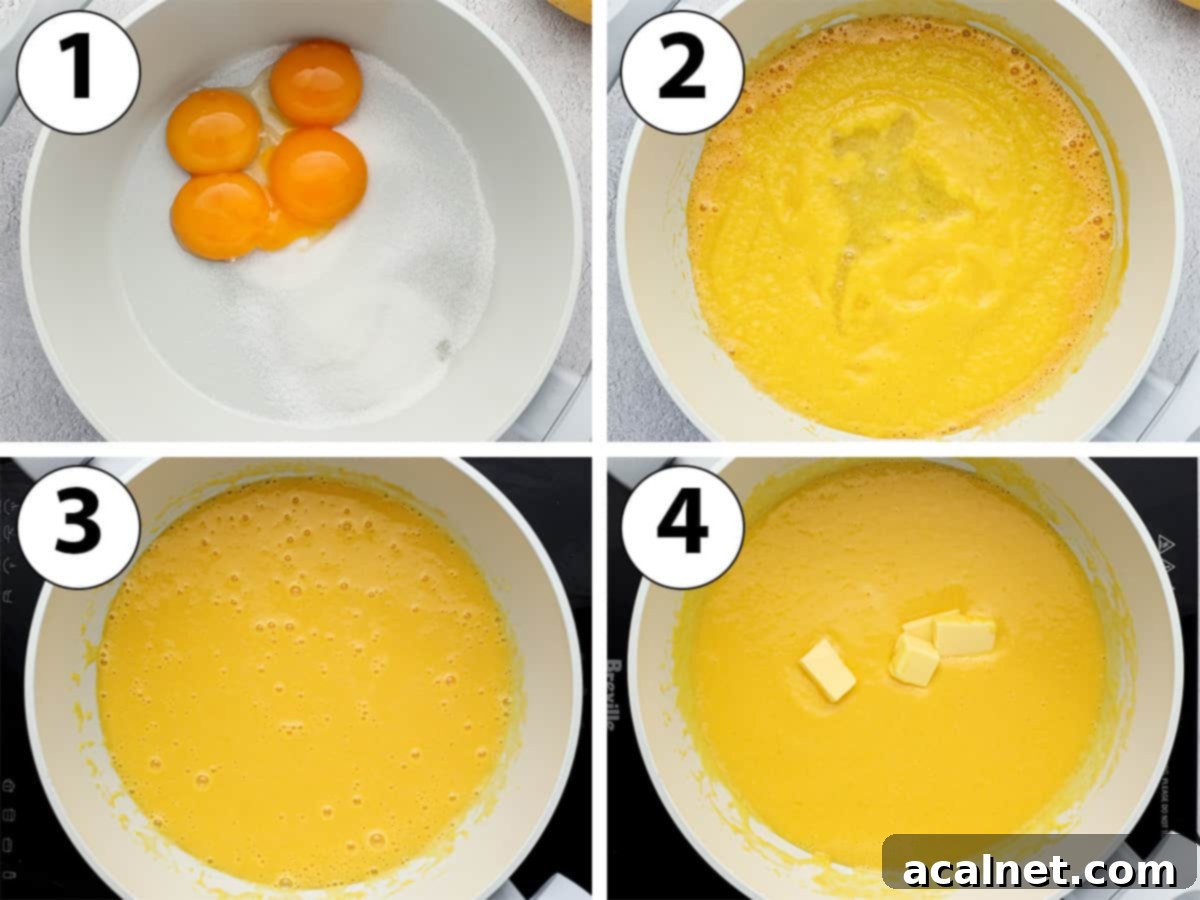
- Prepare the Mango Puree: First, carefully cut your mango, removing the skin and the large pit. Slice the sweet mango flesh into small, manageable cubes. Transfer these cubes to a blender or food processor. Blend thoroughly until you achieve a thin, consistent puree. If you’re using frozen mango, remember to thaw it completely and drain any excess water before blending to avoid a watery curd.
Pro Tip: I personally love a mango curd with a bit of natural texture, so I tend to blend the mango until it’s just liquid, leaving a slight thickness. If you prefer a completely velvety-smooth mango curd, blend the flesh for a longer duration, then, for ultimate smoothness, pass it through a fine-mesh sieve before incorporating it into the other ingredients.
- Combine Wet Ingredients (Photo 1): In a non-reactive, heavy-bottomed saucepan, place your room-temperature egg yolks and caster sugar. It’s crucial to use a non-reactive pan (like stainless steel or enamel-coated) to prevent the lime juice from reacting with the metal, which can impart an unpleasant metallic taste to your curd. Whisk these two ingredients together until they are well combined and the mixture is pale and smooth.
Cookware Note: The size of your saucepan can influence cooking time. As a reference, a medium-sized saucepan works well to ensure even heating.
- Add Mango and Lime (Photo 2): Pour the prepared mango puree and fresh lime juice into the saucepan with the egg and sugar mixture. Whisk everything together thoroughly until all ingredients are fully incorporated.
- Gentle Heating Begins (Photo 3): Place the saucepan on the stove over very low heat. Begin stirring continuously with a heat-proof rubber spatula or a wooden spoon. Continue stirring gently for about 3 to 4 minutes. During this initial phase, the sugar will fully dissolve into the liquid, and you’ll notice the mixture starting to thicken ever so slightly.
Crucial Warning: Never increase the heat above low or medium-low. High heat will cook the eggs too quickly, causing them to scramble and result in a lumpy, curdled, or “eggy” curd. The mixture should only ever simmer gently and must never reach a rolling boil.
- Incorporate the Butter (Photo 4): Once the mixture has slightly thickened and the sugar dissolved, begin adding the cubed unsalted butter. Add the butter a small amount at a time, stirring constantly until each addition is completely melted and smoothly integrated into the curd before adding the next batch. This gradual addition helps emulsify the butter, creating a rich and glossy texture.
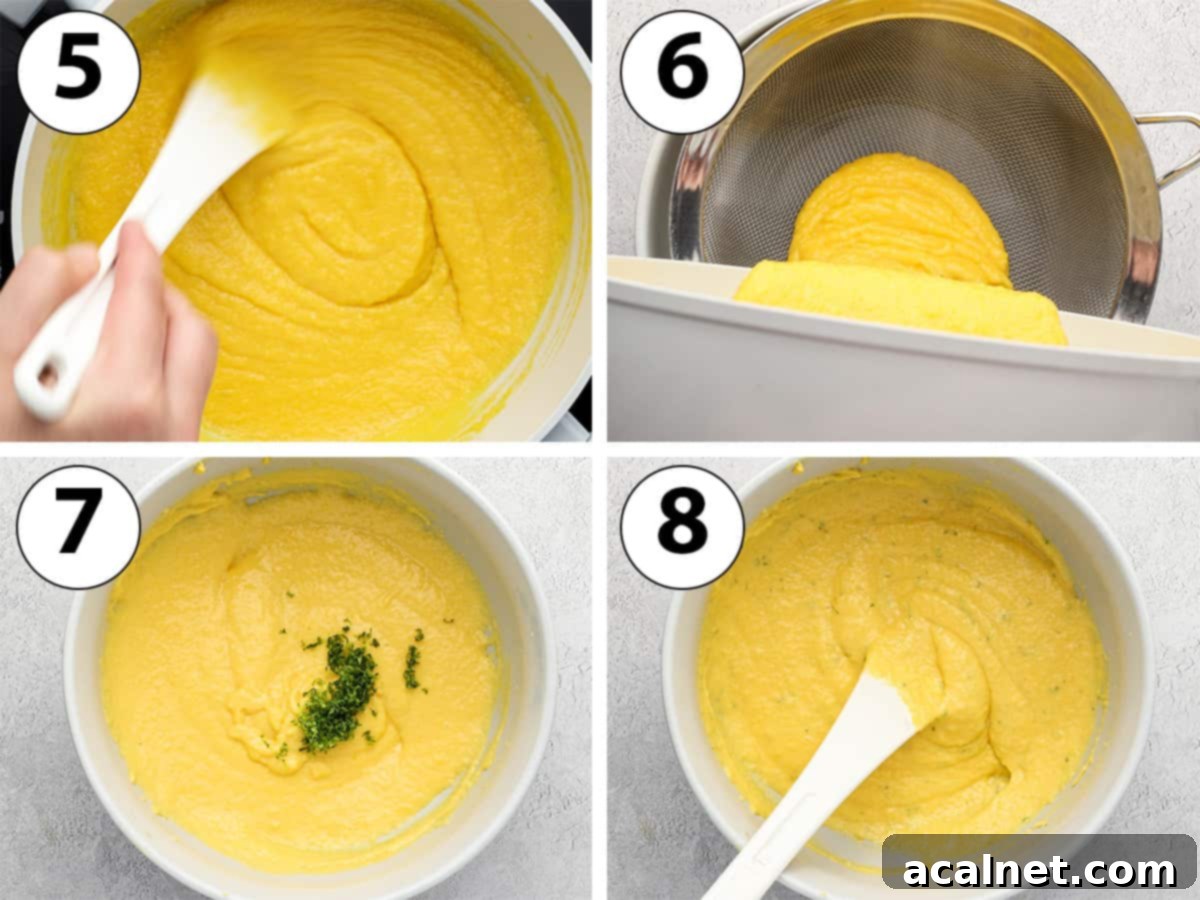
- Continue Cooking to Thicken (Photo 5): Once all the butter has been completely incorporated, continue to cook the curd for another 5 to 8 minutes, or until it has visibly thickened. The exact cooking time can vary based on your stove’s heat and saucepan size, so rely on visual cues and temperature. The curd should be thick enough to generously coat the back of a spoon or spatula.
Doneness Test: Ideally, use a kitchen thermometer to accurately check if the curd is fully cooked. It should reach a temperature of approximately 82 degrees Celsius (180 degrees Fahrenheit) for optimal thickening and food safety.
- Strain for Smoothness (Photo 6): Immediately after cooking, place a fine-mesh sieve over a large, clean bowl. Pour the hot, cooked mango curd through the sieve. Using your spatula, gently stir and press the curd through the mesh. This step is crucial for achieving an incredibly smooth, luxurious texture, removing any tiny lumps, bits of cooked egg, or remaining mango fibers. Make sure to scrape the bottom of the sieve to collect all the delicious curd. Discard any remaining solids.
- Add Lime Zest (Photo 7 & 8): Once strained, add the fragrant lime zest to the warm curd. Stir gently until it is just combined. Adding the zest at this stage preserves its bright, fresh aroma and flavor.
- Chill and Set: Transfer the warm curd into clean glass jars or an airtight container. To prevent a “skin” from forming on the surface as it cools, press a piece of plastic wrap directly onto the surface of the curd. This creates an airtight seal.
Patience is Key: Place the curd in the fridge to chill for at least 2 hours, though preferably overnight. The curd will continue to thicken and fully set as it cools, developing its rich, spreadable consistency. Store the finished mango curd in the refrigerator.
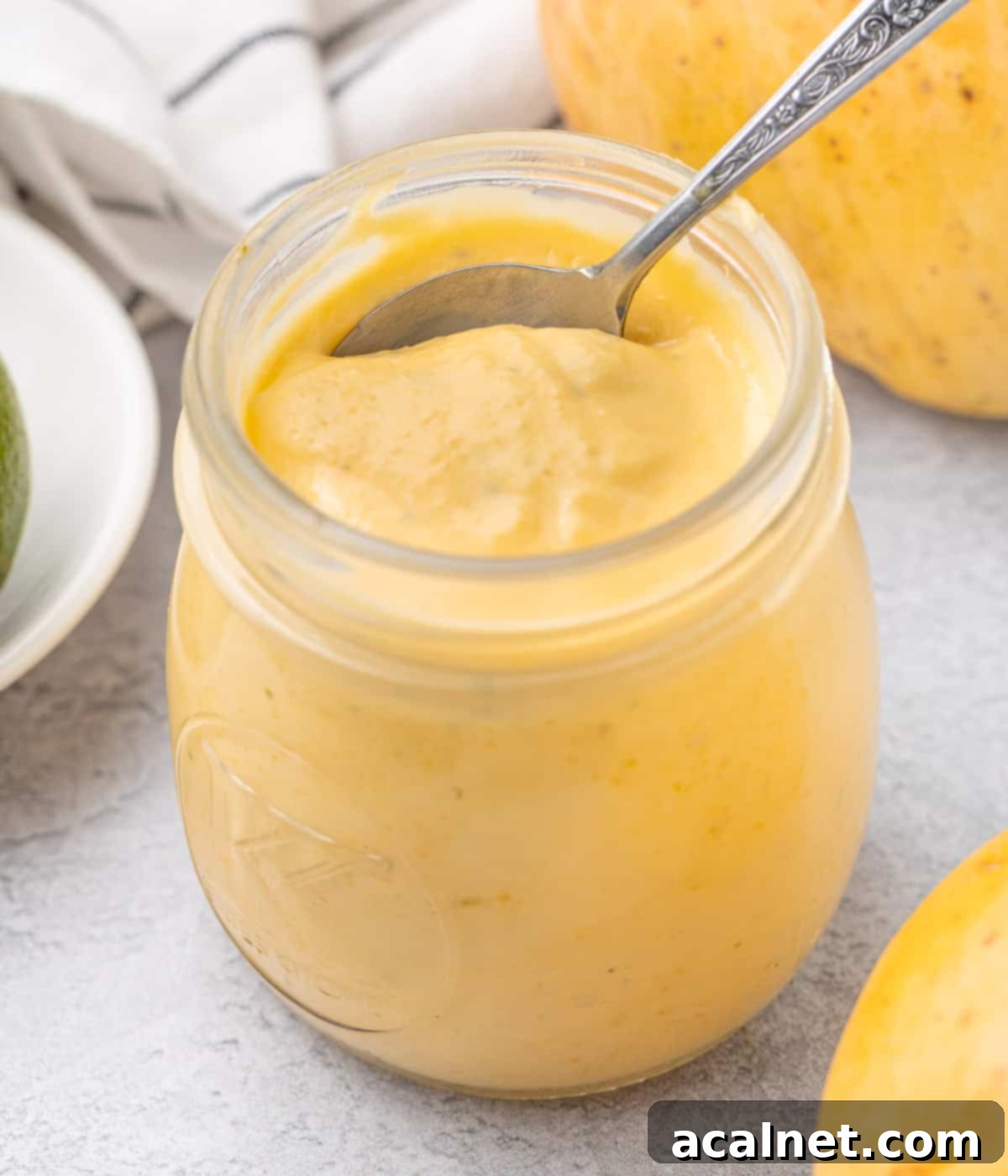
Common Questions About Mango Curd
Yes, you can absolutely use frozen mango chunks! Just be sure to fully thaw them beforehand and carefully discard any excess water or liquid that drains out. This step is important to prevent the curd from becoming too watery. Canned mango will technically work as well, but be aware that canned mangoes are often stored in sweet syrup, which will significantly alter the overall sweetness and flavor profile of your curd. For the best and most authentic taste, fresh, ripe mango is always recommended.
Selecting a perfectly ripe mango is key to a flavorful curd. Here are a few indicators to look for:
– Feel the Mango: Gently press the mango with your fingers. A ripe mango should yield slightly and feel soft, similar to a ripe avocado or peach. If it feels hard, it’s not yet ripe and needs more time.
– Check the Aroma: A ripe mango will emit a distinctly fragrant, sweet, and tropical scent, particularly around the stem end. If there’s no scent, or it smells sour, it’s likely not ready.
– Observe the Color: While color can vary significantly by mango variety, many popular types (like Ataulfo or Honey mangoes) will turn a deep yellow or orange when ripe. Reddish hues on some varieties (like Tommy Atkins) are often just cosmetic and don’t necessarily indicate ripeness; focus more on touch and smell.
Ensuring your curd is properly cooked is vital for its texture and stability. There are two reliable methods to determine if it’s ready:
– Temperature Check: The most precise method is to use a reliable kitchen thermometer. The curd needs to reach a temperature of 82 degrees Celsius (180 degrees Fahrenheit). This temperature ensures the egg yolks are fully cooked and the curd will set properly.
– The Spoon Test: Dip the back of a clean spoon or spatula into the curd. Draw a clear line across the back of the spoon with your finger (be extremely careful, as the curd will be hot!). If the line remains distinct and the curd doesn’t immediately run together to fill the gap, it’s ready. If the curd is still liquid and flows over the line, continue cooking and stirring gently until it reaches the correct consistency.
Due to its sugar content and the acidity provided by the lime juice, this mango curd does possess properties that make it suitable for canning and preservation. The sugar acts as a preservative, and the acidity helps create an environment less hospitable to spoilage.
However, I personally do not have extensive experience with home canning, so I highly recommend consulting reputable canning guides or recipes that provide specific, detailed instructions for safely preserving fruit curds. Proper canning techniques are essential to ensure food safety and shelf stability.
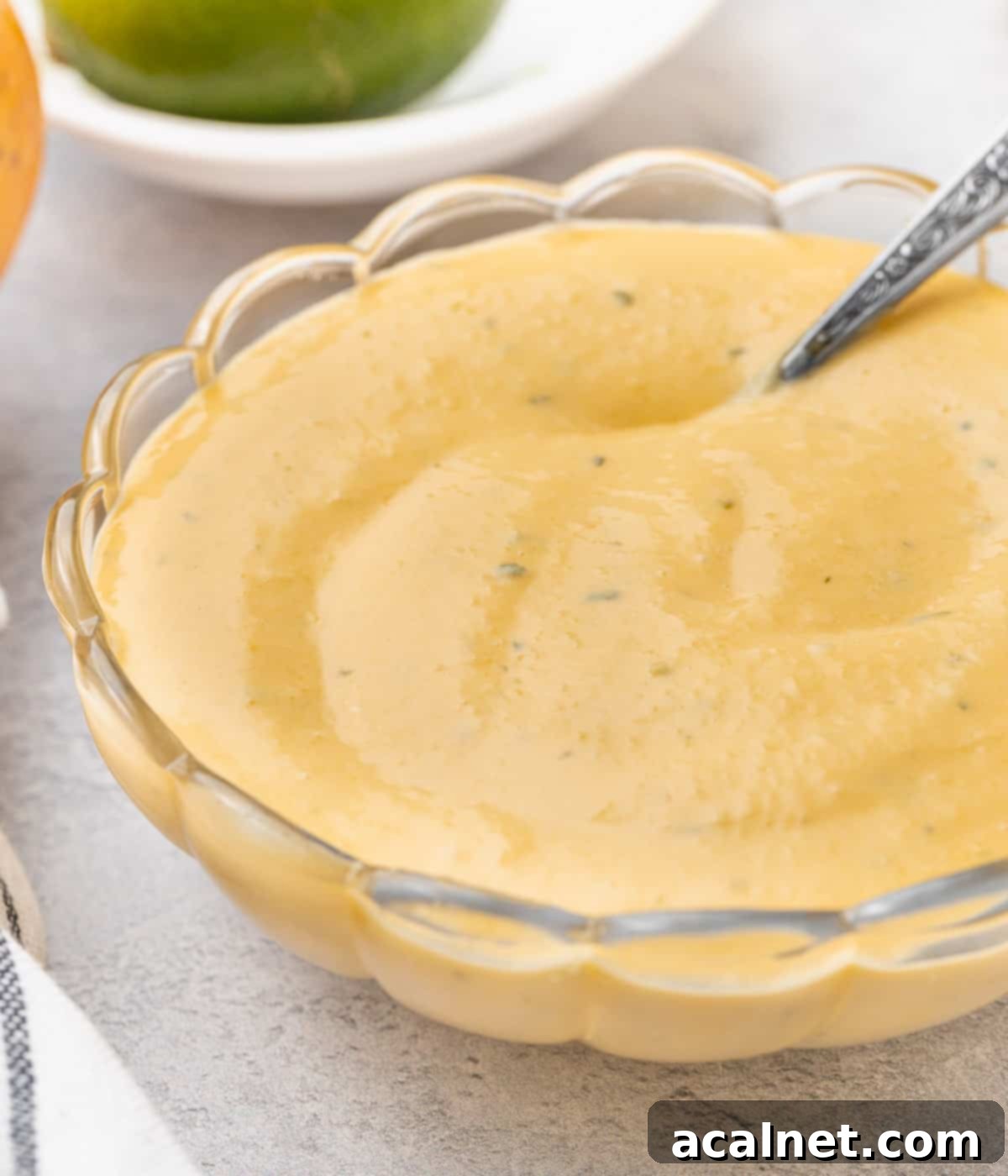
Pro Tips & Troubleshooting for Perfect Mango Curd
Even though mango curd is relatively simple, knowing a few tricks and how to handle common issues can elevate your results from good to absolutely perfect.
- Direct Heat vs. Double Boiler Method: The recipe primarily uses the “direct heat” method, where you cook the curd directly in a saucepan over low heat. This is generally quicker, but it demands constant attention to avoid overcooking the eggs. Alternatively, the “indirect heat” method (using a heat-proof bowl set over a pot of simmering water – a double boiler) takes longer to thicken but provides a much gentler, more forgiving cooking environment, significantly reducing the risk of scrambling the eggs or burning the curd. If you’re new to making curds, the double boiler method might be a safer bet for peace of mind.
- My Mango Curd is Lumpy or Eggy: This is a common issue that typically arises if the heat is too high, causing the eggs to cook too rapidly and scramble. Remember, the curd should only ever reach a gentle simmer, never a vigorous boil. If you find your curd has lumps or an “eggy” texture, don’t despair! You can often salvage it by immediately pouring the curd through a very fine-mesh sieve or strainer to remove the cooked egg bits. For an even smoother finish, once strained, you can use an immersion blender for a quick pulse or two. However, be cautious not to over-blend, as this can incorporate too much air or break down the starches, potentially making the curd thinner.
- Why is My Curd Too Liquid or Not Thickening? The most likely reason is that it hasn’t cooked enough yet. Making curd is a process that requires patience, as it relies on very low heat to gently thicken the eggs without scrambling them. Keep stirring constantly until it reaches the desired consistency. Also, remember that curd continues to thicken considerably as it chills in the refrigerator, so don’t expect it to be jelly-like straight off the stove. Trust the process and the temperature guidelines.
- How Thick Should the Curd Be? A perfectly cooked curd should be thick enough to coat the back of a spoon thoroughly. When you run your finger across the coated spoon, a clean path should remain. You can also customize the final texture of your mango curd by how much you blend the mango flesh initially. I prefer a slightly thicker curd, so I blend the mango just until liquid, retaining a bit of body. For a thinner, more pourable consistency, blend the mango flesh until it’s very thin and smooth, and definitely pass it through a sieve before using.
Creative Ways to Enjoy Your Mango Curd
The deliciousness of mango curd extends far beyond just spreading it on toast. Its vibrant flavor and creamy texture make it an incredibly versatile ingredient in both sweet and savory applications. Here are some of our favorite ways to enjoy it:
- Breakfast Bliss: Elevate your morning routine by spreading it generously over pancakes, fluffy waffles, rich French toast, delicate crepes, or even simple biscuits and scones. A dollop stirred into your morning yogurt or drizzled over granola is also divine.
- Dessert Dynamo: Use it as a luscious filling or elegant topping for cakes, like the aforementioned Mango Mousse Cake. Its bright flavor is a perfect contrast to richer elements.
- Pastry Perfection: Fill tart shells, mini pastry cups, or use it as a vibrant and tangy filling for delicate macarons. It can also be swirled into cheesecakes or incorporated into a light mousse.
- Topping for Treats: Drizzle it over pavlova, our vegan no-bake mango cheesecake, or a silky mango panna cotta to add an extra layer of tropical goodness.
- Simply Spoonfuls: Honestly, sometimes the best way to enjoy this delicious mango curd is simply on its own, by the spoonful, as a delightful and refreshing dessert!
Storing & Freezing Your Mango Curd
Proper storage is essential to maintain the freshness and vibrant flavor of your homemade mango curd.
Mango curd should always be stored in the fridge. Transfer it to an airtight container or seal it securely in glass jars. While it might technically last a bit longer, for the best flavor, freshest taste, and optimal texture, I recommend consuming it within one week of preparation. Always use a clean spoon each time you retrieve curd to prevent contamination.
Regarding freezing, while curds can be frozen, I personally do not recommend it for mango curd. The freezing and thawing process tends to create an odd, sometimes grainy or separated, texture that doesn’t quite live up to the creamy perfection of freshly made or refrigerated curd. If you must freeze it, understand that the texture might change upon thawing, making it more suitable for baking applications rather than direct spreading.
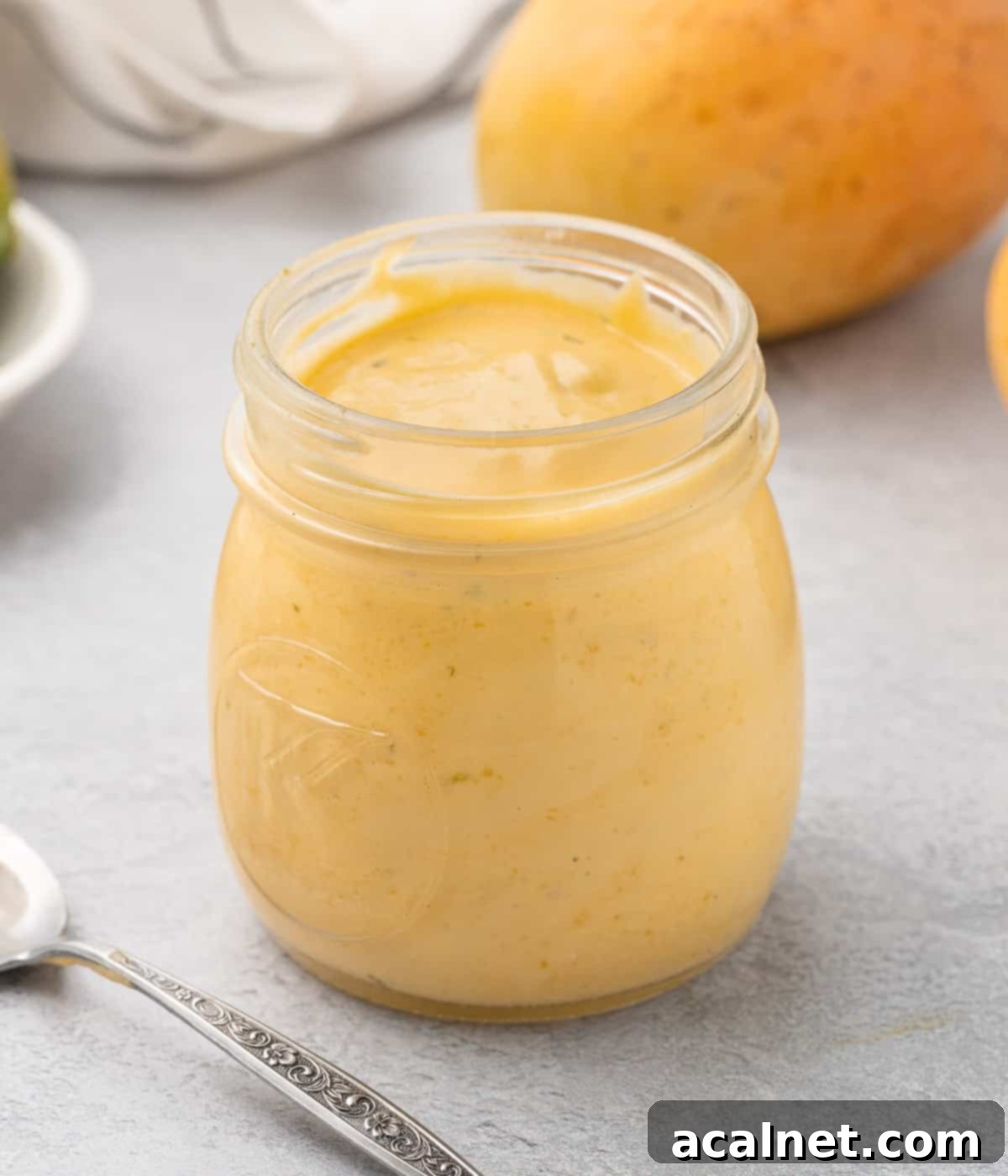
Explore More Fruit Spreads
- Stewed Rhubarb
- Strawberry Compote and Strawberry Coulis
- Blueberry Compote and Blueberry Coulis
- Raspberry Compoteand Raspberry Coulis
- Mixed Berry Compote
- Passion Fruit Coulis
Made this recipe?
Let us know if you liked it by leaving a comment below, and tag us on Instagram @a.baking.journey with a photo of your creation!
Recipe Card
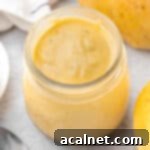
Mango Curd
Servings:
2
cups (about 500 grams)
Author:
Sylvie
7 minutes
15 minutes
2 hours
2 hours
22 minutes
Print Recipe
Prevent your screen from going dark
Ingredients
-
200
gr
Mango Flesh -
4
large
Egg Yolks,
at room temperature -
40
gr
Caster Sugar -
30
ml
Lime Juice,
about 1 lime -
90
gr
Unsalted Butter,
at room temperature -
1
teaspoon
Lime Zest
Instructions
- Cut the mango, remove the skin and pip. Slice the mango flesh into small cubes and place in a blender or food processor. Blend until you get a thin puree (see note 1). If using frozen mango, thaw and drain it first.
- Place the egg yolks and sugar in a non-reactive, heavy based medium saucepan. Whisk to combine then add the mango puree (optionally sieved) and lime juice. Stir then place on the stove.
- Cook for 3 to 4 minutes on low heat, constantly stirring with a heat-proof spatula. The sugar should have dissolved and the mixture should start to thicken very slightly.
- Add the cubed butter a little bit at a time, stirring until completely melted in the mixture before adding more.
- Once all the butter has been incorporated, continue to cook for about 5 to 8 minutes (more or less depending on the heat and size of saucepan). The curd should have thickened, coat the back of a spoon or spatula and reach about 82 degrees Celsius / 180 degrees Fahrenheit (see note 2).
- Place a fine-mesh sieve over a large bowl and pour the cooked mango curd in. Press the curd through the sieve and discard any lumps or bits of cooked eggs (see note 3).
- Add the lime zest and stir until just combined.
- Transfer the curd inside glass jars or airtight container (see note 4) and refrigerate for at least 2 hours, preferably overnight. The curd will set as it chills. Keep in the fridge for up to a week.
Video
Would you like to save this recipe?
We’ll email this post to you, so you can come back to it later!
Notes
- I personally like to keep some texture inside my curd so I used a rather thick mango puree. If you want a very smooth mango curd, you can blend the flesh for longer and / or pour it through a thin mesh sieve before using it.
- Make sure not to go over medium heat or the eggs will cook too quickly and start to scramble, resulting in a curdle or lumpy curd. The curd should only go as high as a simmer – and never boil.
- If you find the curd to be still lumpy after sieving it, you can use an immersion blender to smooth it out. Be careful not to blend too much or the curd will turn too liquid and won’t set properly.
- If stored in containers, I recommend covering the top of the curd with plastic wrap touching its surface so that it does not create a skin on top.
Nutrition (per serving)
Calories:
588
kcal
|
Carbohydrates:
41
g
|
Protein:
7
g
|
Fat:
46
g
|
Saturated Fat:
26
g
|
Polyunsaturated Fat:
3
g
|
Monounsaturated Fat:
14
g
|
Trans Fat:
1
g
|
Cholesterol:
464
mg
|
Sodium:
23
mg
|
Potassium:
277
mg
|
Fiber:
2
g
|
Sugar:
38
g
|
Vitamin A:
2976
IU
|
Vitamin C:
50
mg
|
Calcium:
71
mg
|
Iron:
1
mg
